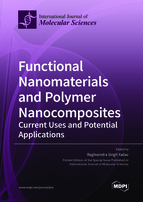Functional Nanomaterials and Polymer Nanocomposites: Current Uses and Potential Applications
A special issue of International Journal of Molecular Sciences (ISSN 1422-0067). This special issue belongs to the section "Materials Science".
Deadline for manuscript submissions: closed (30 May 2022) | Viewed by 36128
Special Issue Editor
Interests: magnetic materials; dielectric materials; electrical properties; luminescent nanomaterials; microwave absorbing materials; ceramics; materials chemistry; soft matter; nanostructured materials; materials for energy
Special Issues, Collections and Topics in MDPI journals
Special Issue Information
Dear Colleagues,
Recently, smart nanoparticles have received a great deal of attention among researchers and academicians due to their unique physical properties and wide applications, including drug delivery, biomimetic devices, contrast agents in magnetic resonance imaging, hyperthermia, cell manipulation, security systems, information storage devices, quantum computing, magnetic sensors and actuators, energy harvesting, catalysis and magnetic separation, spintronic-based devices, electronic devices, lasers, Li-ion batteries, solar cells, bio-imaging, thermal therapy, etc. Prompt technological improvement and miniaturization require immediate developments in materials science to achieve increased performance demands. Polymer nanocomposites have received a great deal of attention regarding the design of a new generation of high-performance composite materials based on smart nanoparticles due to their extraordinarily high synergetic and complementary characteristics between two or more component materials. The characteristics of polymer nanocomposites can be modified by selectively introducing smart nanoparticles with unique physical properties for the desired application. Additionally, the reduced size of smart nanoparticles increases the aspect ratio, which can play a fundamental role in enhancing the interfacial properties in the overall performance of innovative polymer nanocomposite materials for emerging technology.
We invite authors to contribute original research articles or comprehensive review articles covering the most recent progress and new developments in the synthesis of smart nanoparticles; the preparation of polymer nanocomposites; the characterization and application of smart nanoparticles; the physical properties of polymer nanocomposites; and the utilization of smart nanoparticles in the design of advanced polymer nanocomposites for emerging technologies including biomedical, optoelectronics, sensing, diagnostics, food packaging, organic photovoltaics, bioelectronics, electronics, energy storage, automobiles, aerospace engineering, biomedicine, supercapacitors, batteries, water and air purification, microwave absorbers, etc.
This Special Issue aims to cover a broad range of subjects, from smart nanoparticles and polymer nanocomposite synthesis and the study of their fundamental properties to the fabrication and characterization of devices and emerging technologies with smart nanoparticles and polymer integration.
Manuscripts can be submitted in the following formats: full research papers, communications, and reviews.
Dr. Raghvendra Singh Yadav
Guest Editor
Manuscript Submission Information
Manuscripts should be submitted online at www.mdpi.com by registering and logging in to this website. Once you are registered, click here to go to the submission form. Manuscripts can be submitted until the deadline. All submissions that pass pre-check are peer-reviewed. Accepted papers will be published continuously in the journal (as soon as accepted) and will be listed together on the special issue website. Research articles, review articles as well as short communications are invited. For planned papers, a title and short abstract (about 100 words) can be sent to the Editorial Office for announcement on this website.
Submitted manuscripts should not have been published previously, nor be under consideration for publication elsewhere (except conference proceedings papers). All manuscripts are thoroughly refereed through a single-blind peer-review process. A guide for authors and other relevant information for submission of manuscripts is available on the Instructions for Authors page. International Journal of Molecular Sciences is an international peer-reviewed open access semimonthly journal published by MDPI.
Please visit the Instructions for Authors page before submitting a manuscript. There is an Article Processing Charge (APC) for publication in this open access journal. For details about the APC please see here. Submitted papers should be well formatted and use good English. Authors may use MDPI's English editing service prior to publication or during author revisions.
Keywords
- smart nanoparticles
- synthesis and characterization
- polymer nanocomposites
- energy applications
- biomedical applications
- environmental applications







